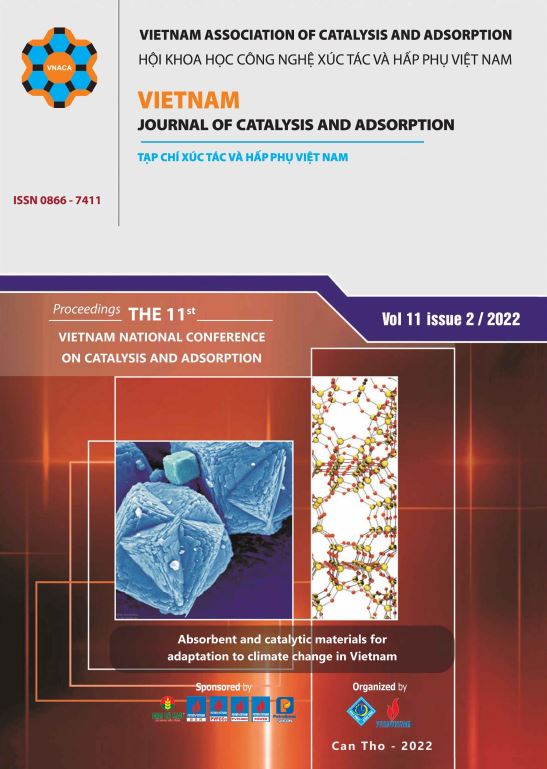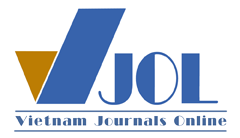Degradation of recalcitrant organic pollutants by modified TiO2 photocatalysts
DOI:
https://doi.org/10.51316/jca.2022.035Keywords:
Photocatalyst TiO2, a doped, tetracycline antibiotics, ilmeniteAbstract
Non-metallic C, N, and S doped TiO2 materials were prepared using the hydrothermal method from titanyl sulfate solution with different doped precursors. The influence of non-metallic elements on crystal structure, morphology, surface area, bonding state, and light absorption ability of materials was studied through XRD, SEM, BET spectra, and UVis - DRS. The formation of new Ti-O-C, O-N-Ti bonds, the insertion of non-metallic elements into the TiO2 crystal lattice, or the replacement of Ti4+ with S6+ has created a redshift in the bandgap energy of the material doping. The increase in the specific surface area of the doped materials is their enhanced photocatalytic activity. The results demonstrate that the C, N, and S co-doped TiO2 (TH-TiO2) material has the best action for degrading tetracycline (TC) antibiotics.
Downloads
References
Palominos R. A., Mondaca M. A., Giraldo A., Peñuela G., Pérez-Moya M., and Mansilla H. D., Catalysis Today 144 1-2 (2009) 100-105.
https://doi.org/10.1016/j.cattod.2008.12.031
Bacsa R., J. Kiwi, T. Ohno, P. Albers, and V. Nadtochenko, (in E), The Journal of Physical Chemistry B 109 12 (2005) 5994-6003. https://doi.org/10.1021/jp044979c
Addamo M. et al., in J. Appl. Electrochem 35 (2005) 765–774. https://10.1007/s10800-005-1630-y
Khan M.H., Bae H., and Jung J.Y., (in E), J. Hazard Mater 181 1 (2010) 659–665. https://doi.org/10.1016/j.jhazmat.2010.05.063
Dobaradaran S. et al., (in E), Iran J Environ Health Sci Eng 7 4 (2010) 307–312.
Gotvajn A. Z., Bistan M., Tisler T., Englande A. J., and Zagorc-Koncan J., in Int J Environ Sci Technol 10 (2013) 1141–1148.
https://doi.org/10.1007/s13762-012-0153-4
Fujishima A., Hashimoto K., and Watanabe T., in A Revolution in cleaning technology (1999) 14-21.
N. T. Lan et al., Journal of Nanomaterials 2020, (2020). https://doi.org/10.1155/2020/1523164
J. Atanelov, C. Gruber, and P. Mohn, Computational Materials Science 98 (2015) 42-50. https://doi.org/10.1016/j.commatsci.2014.10.041
S. Sakthivel and H. Kisch, Angewandte Chemie International Edition 42 40 (2003) 4908-4911. https://doi.org/10.1002/anie.200351577
F. Tian and C. Liu, The Journal of Physical Chemistry B 110 36 (2006) 17866-17871. https://doi.org/10.1021/jp0635462
J. C. González-Torres, E. Poulain, V. Domínguez-Soria, R. García-Cruz, and O. Olvera-Neria, International Journal of Photoenergy 2018, (2018), https://doi.org/10.1155/2018/7506151
L. G. Devi and R. Kavitha, (in E), Materials Chemistry and Physics 143 3 (2014) 1300-1308. https://doi.org/10.1016/j.matchemphys.2013.11.038
K. S. W. Sing, (in E), Pure and applied chemistry 57 4 (1985) 603-619. https://doi.org/10.1351/pac198557040603
M. D. Donohue and G. L. Aranovich, (in E), Fluid Phase Equilibria 158 (1999) 557-563, https://10.1016/S0378-3812(99)00074-6.
H. Zhang et al , RSC Advances 5 129 (2015) 107150-107157. https://doi.org/10.1039/C5RA23743B
L. Jingpeng et al., (in E), RSC Advances 7 87 (2017), 55131-55140. https://10.1039/C7RA10103A
X. Zhu, Z. Liu, J. Fang, S. Wu, and W. Xu, (in E), Journal of Materials Research 28 10 (2013) 1334-1342.
https://doi.org/10.1557/jmr.2013.92
Y. Huynh and N. Le, Science and Technology Development Journal 18 (2015) 81-91, https://10.32508/stdj.v18i1.1037.
N. Kannadasan, N. Shanmugam, S. Cholan, K. Sathishkumar, G. Viruthagiri, and R. Poonguzhali, Materials characterization 97 (2014) 37-46. https://doi.org/10.1016/j.matchar.2014.08.021
N. F. Djaja and R. Saleh, Materials Sciences and Applications 4 02 (2013) 145. https://10.4236/msa.2013.42017











